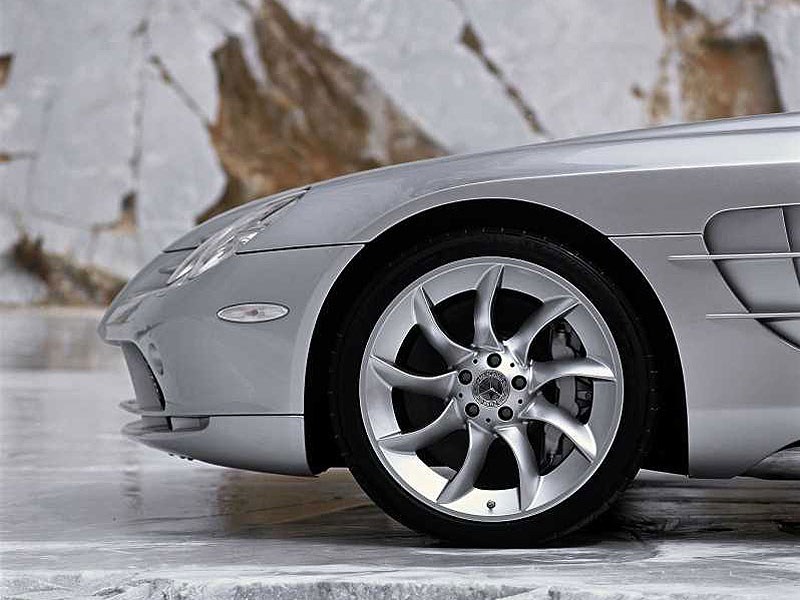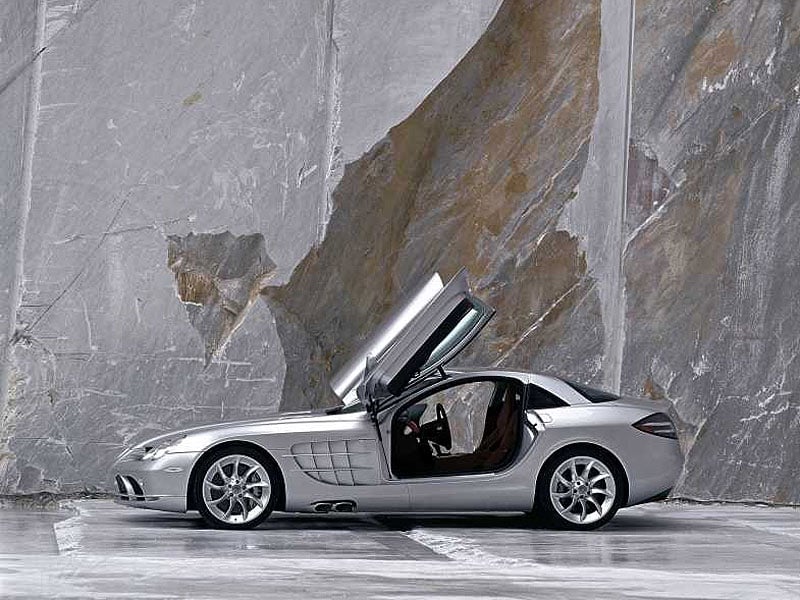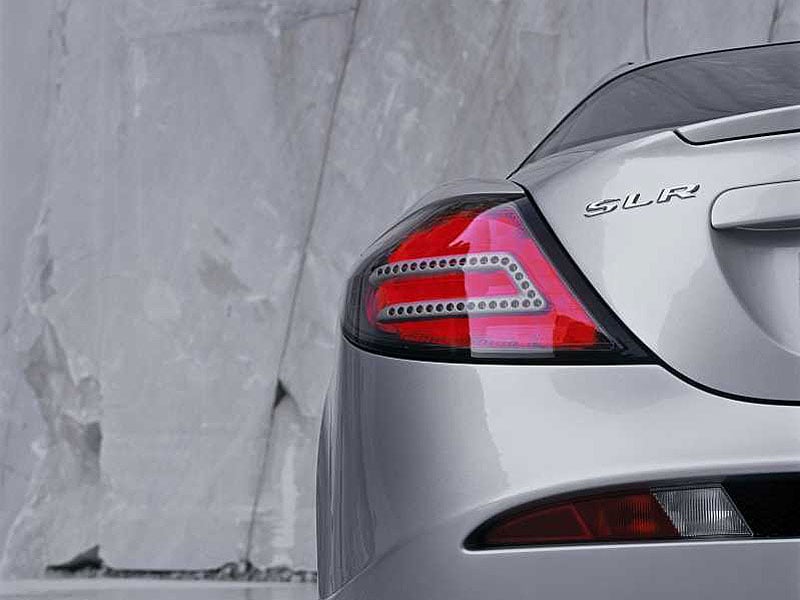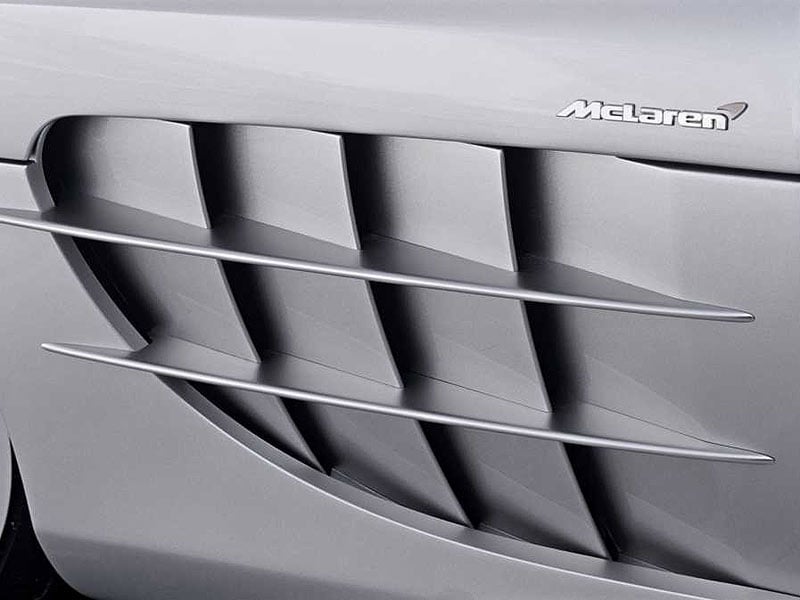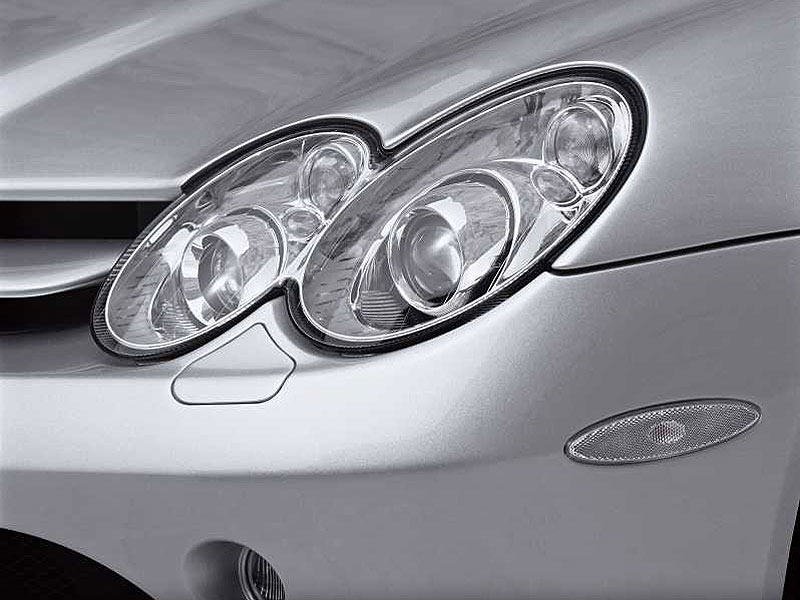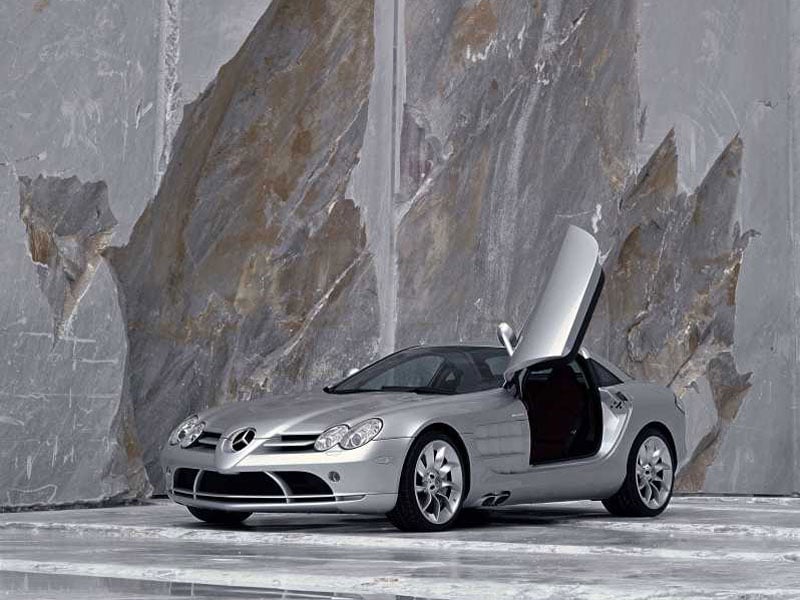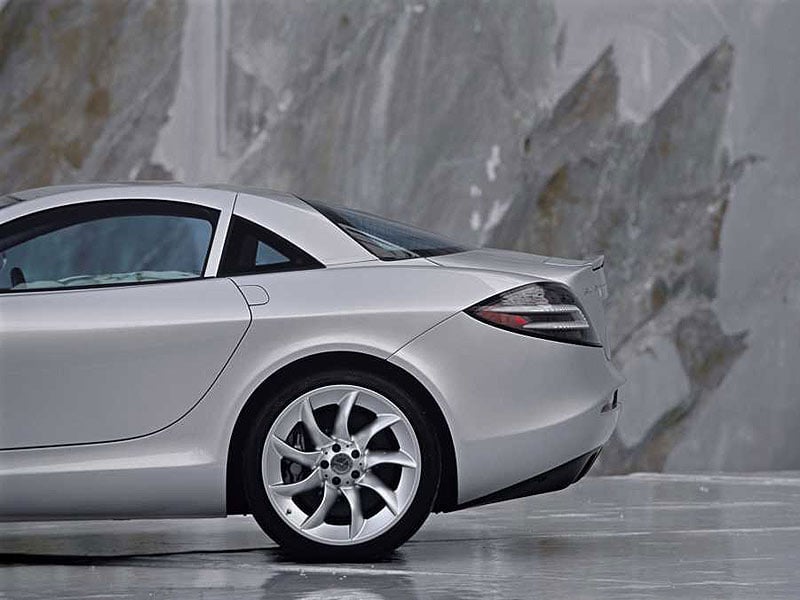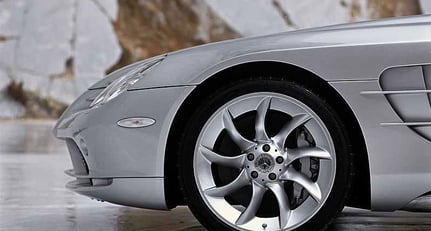Styling inheritance
Text/Photos - Mercedes-Benz
It's the long, sweeping lines of the bonnet, the succinctly styled air gills in the wings, the eye-catching sidepipes, the compact tail and, last but by no means least, the gullwing doors which breathe life into the SLR legend. These design features first caused a sensation back in 1952, and have remained the hallmark of thoroughbred Mercedes sports cars ever since.
These and other styling elements rooted in the SLR tradition are harmonised smoothly with the latest Mercedes design traits: these include the distinctive "twin-headlamp face", which has been blazing a trail since it first appeared in 1995, and the fascinating interplay of soft contours and taut lines, a characteristic which runs through many of the models in the current Mercedes portfolio.
The bodystyling of the SLR is also modelled on the McLaren Mercedes Silver Arrows. The arrow-shaped nose, which encompasses the Mercedes star at the front and gives the bumper as a whole a bolder, more powerful look, stems from the championship-winning Formula One car; as does the twin-fin spoiler in the front bumper. Again, this is more than just an identifying design feature, as it is also crucial to the vehicle's aerodynamics and engine cooling.
Seen from the side, the eye is immediately caught by the flat, wedge-shaped form of the new high-performance supercar. This is created primarily by the long bonnet, the steeply raked front windscreen, the rearwards positioning of the passenger cockpit, the large wheels and the compact tail. Thanks to these proportions, the side profile lends further emphasis to the sense of forwards surge which courses through the new SLR.
The designers have incorporated a further SLR element in the form of the finned side air gills in the front wings, although they do far more than recall just the design of the legendary racing cars from 1955; today, as indeed back then, the side air outlets serve to ventilate the engine compartment. The designers have underlined their practical function by the use of sweeping lines which continue into the gullwing doors.
 Stay informed! Subscribe here to our weekly newsletter.
Stay informed! Subscribe here to our weekly newsletter.
Ultimate performance
Just like its legendary predecessor of 1955, this SLR incorporates new technological developments which are ahead of their time.
For evidence of this, simply take a glance under the bonnet at the Mercedes-AMG V8 powerplant. With its 5.5-litre displacement and screw-type compressor, the engine develops a peak output of 460 kW/626 hp and delivers its maximum torque of 780 NM from 3250 rpm – a figure which remains constant across a broad engine speed range of up to 5000 rpm.
With this kind of power under the bonnet, the Mercedes-Benz SLR McLaren delivers performance figures which are among the best in its class: this high-performance sports car takes just 3.8 seconds to sprint from 0 to 62mph/100 km/h, it passes the 124mph/200 km/h mark after 10.6 seconds, and from a standing start it takes just 28.8 seconds to reach186mph/ 300 km/h. The two-seater has a provisional top speed of 207mph/334 km/h.
In the interests of optimum weight distribution, optimum dynamic handling and high stability on braking, the Mercedes-Benz SLR McLaren has a front mid-engined design. The V8 powerplant is mounted on a robust aluminium frame and has a low installation position. Water-type charge-air cooling, three valves per cylinder, dry sump lubrication and four metal catalytic converters are further special features of this powerful engine – an engine which already meets stringent EU 4 exhaust gas regulations which are not due to come into force until 2005.
The 5-speed automatic transmission, fitted as standard, is also designed for high performance. It allows the driver to choose between three programs, letting him or her determine the shift speed individually. When "Manual" is selected, the five gears can either be shifted using buttons on the steering wheel or using the selector lever's Touchshift function. In manual mode the driver can select between three shift stages – "Sport", "SuperSport" and "Race" – significantly shortening the shift times still further for an even sportier drive.
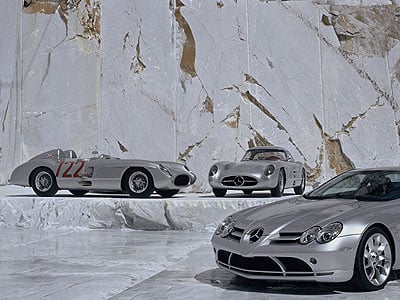
Safety F1rst
The bodyshell of the high-performance sports car is also distinctly high-tech. Along with the front and rear structure and the passenger cell, the swing-wing doors and the bonnet, it is made entirely from carbon fibre composite. This light-weight yet extremely rigid material originated in the aeronautical and space industries and has also proven its benefits in today's Formula 1 race cars. The weight advantage of the high-tech material over steel is around 50 percent.
In addition to this, carbon fibres, on impact, are characterised by four to five times higher energy absorption than steel or aluminium. Mercedes-Benz exploits these qualities by inserting two 620-millimetre longitudinal members made from carbon fibre in the front structure of the new SLR. These absorb the entire energy of the crash in a head-on collision without exceeding tolerable deceleration values for the occupants. In an impact the fibres of these elements shred from front to rear with precisely calculated deformation behaviour, ensuring constant deceleration.
This makes the SLR the world's first series-produced car to have a front crash structure made entirely from carbon fibre. The carbon fibre longitudinal members each weigh just 3.4 kilograms.
The passenger cell of the high-performance sports car is also made entirely from this high-tech material. In a head-on, side-on or rear-end collision, it offers the passengers an extremely rigid, safe survival zone. At the rear, two internal longitudinal members made from laminated carbon fibre and a robust cross member take on the task of energy absorption in the event of a crash – as a rule the passenger cell remains structurally unaffected.
Adaptive front airbags which deploy in two stages depending on the severity of the accident, newly developed sidebags which protect the head, plus belt tensioners and belt force limiters all form part of the new SLR's occupant protection system.
The brake discs of the cutting-edge swing-wing door vehicle are also made from a high-tech material which meets the highest of standards. Here Mercedes-Benz has used carbon fibre-reinforced ceramic to achieve outstanding performance, temperature-resistance and longevity. Thanks to the highly robust material, the SLR's large brake discs allow maximum deceleration of up to 1.3 g – a top value in a series-produced car. At the front axle alone a total brake pad area of 440 cm2 is available.
Further features of the new SLR include Sensotronic Brake Control (the electro-hydraulic braking system), the Electronic Stability Program (ESP ®), automatic tyre pressure monitoring, 18-inch wheels and aluminium suspension which bears the signature of experienced race car constructors – all of which create the necessary criteria for perfect dynamic handling and excellent driving safety.


The facts;
| Engine: | 5439cc V8 Bore and stroke 97 x 92 mm. 8.8 compression ratio Three valves/cylinder |
| Power: | 626 bhp @ 6500rpm |
| Torque: | 780 Nm at 3250-5000 rpm |
| Transmission: | Five speed fully automatic in two modes -
"Comfort" "Sport" Or "Manual" via buttons on steering wheel, or gearshift in three levels of performance - Stage I = “Sport” Stage II = “SuperSport” Stage III = “Race” |
| Suspension: | All aluminium double wishbone |
| Brakes: | Fibre-reinforced ceramic brake discs. 8 piston front, 4 piston rear. |
| Wheels and tyres: | Standard 10 spoke 18" design. Front:245/40 ZR 18 on 9.0 J x 18 ET 45. Rear: 295/35 ZR 18 on 11.5 J x 18 ET 44. |
| Dimensions: |
Wheelbase: 2.660 mm Length:4.564 mm Width: 1.878 mm. Height 1.247 mm. |
| Acceleration: | 0 -62.5 mph 3.8s 0-124 mph 10.6s 0-186 mph 28.8s |
| Top speed: | 208 mph |
| Price & availablity: | In the region of €300,000. To be officially launched at the Frankfurt Show - September 2003. |
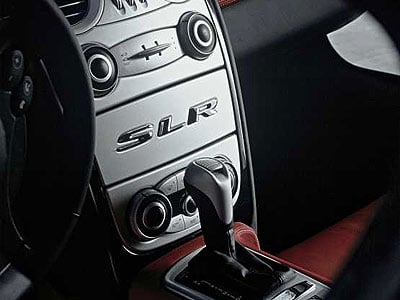

Galerie
